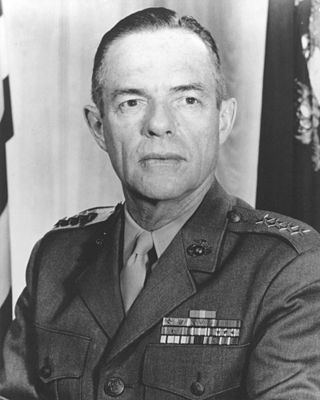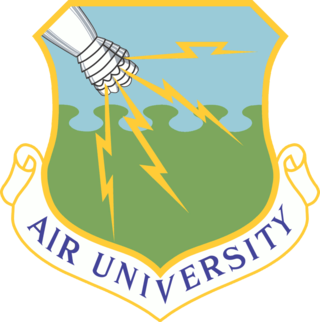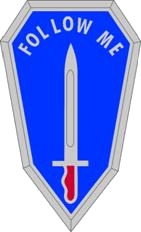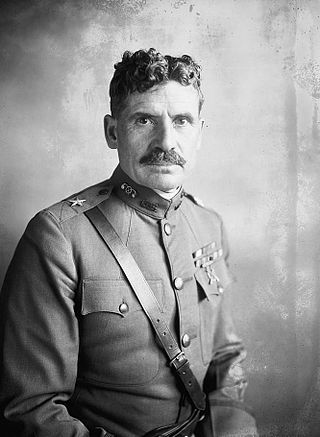The United States Army Gas School was established during World War I at Camp A.A. Humphreys in Virginia. The first courses began in May 1918 and the school was designed to instruct commissioned and noncommissioned officers in chemical warfare.
In late October 1917 the War College was badly underprepared for large-scale chemical warfare in World War I. With many U.S. soldiers operating in a chemical environment with no knowledge of chemical warfare the War College requested a British gas officers and NCOs, the requests were granted. The British experts arrived and were directed and coordinated by Major S.J.M. Auld. Auld was tasked with composing a "working textbook on gas" for the U.S. Army. [1]
Among Auld's recommendations was an idea the General Staff had already been considering, the establishment of a central Army Gas School. As a result of Auld's suggestion the Army Gas School was established at Camp A.A. Humphreys, Virginia. The school, beginning in May 1918, offered two initial courses. One course was a four-day class on general information about gas warfare and was offered to commissioned and noncommissioned officers. The second course was a 12-day affair for Chief Gas Officers which went into greater detail about chemical warfare. [1]
Upon its establishment, Ross A. Baker was given charge of training for Chief Gas Officers at the Army Gas School. Baker was the Chief Gas Officer at Camp Pike in Arkansas and a professor of chemistry at the University of Minnesota before taking the post at Camp Humphreys. [2] Later in the month of October 1917 the entire Army Gas School operation was transferred to Camp Kendrick. [3]

Fort Dix, the common name for the Army Support Activity (ASA) located at Joint Base McGuire–Dix–Lakehurst, is a United States Army post. It is located 16.1 miles (25.9 km) south-southeast of Trenton, New Jersey. Fort Dix is under the jurisdiction of the Air Force Air Mobility Command. As of the 2020 U.S. census, Fort Dix census-designated place (CDP) had a total population of 7,716, of which 5,951 were in New Hanover Township, 1,765 were in Pemberton Township, and none were in Springfield Township.

The use of toxic chemicals as weapons dates back thousands of years, but the first large scale use of chemical weapons was during World War I. They were primarily used to demoralize, injure, and kill entrenched defenders, against whom the indiscriminate and generally very slow-moving or static nature of gas clouds would be most effective. The types of weapons employed ranged from disabling chemicals, such as tear gas, to lethal agents like phosgene, chlorine, and mustard gas. This chemical warfare was a major component of the first global war and first total war of the 20th century. The killing capacity of gas was limited, with about 90,000 fatalities from a total of 1.3 million casualties caused by gas attacks. Gas was unlike most other weapons of the period because it was possible to develop countermeasures, such as gas masks. In the later stages of the war, as the use of gas increased, its overall effectiveness diminished. The widespread use of these agents of chemical warfare, and wartime advances in the composition of high explosives, gave rise to an occasionally expressed view of World War I as "the chemist's war" and also the era where weapons of mass destruction were created.

Chemical, biological, radiological and nuclear defence or NBC protection are protective measures taken in situations in which chemical, biological, radiological or nuclear warfare hazards may be present. CBRN defence consists of CBRN passive protection, contamination avoidance, and weapons of mass destruction mitigation.

Camp Leach, formerly known as the American University Experimental Station and Camp American University, was a World War I era United States Army camp built by the Corps of Engineers on American University property in Washington, D.C. It was named in honor of Colonel Smith S. Leach, Corps of Engineers. The camp was established in 1917 for the organization of engineer units and subsequently used by the Chemical Warfare Service. Abandoned in January 1919, it was ordered salvaged.

Wallace Martin Greene Jr. was a United States Marine Corps four-star general who served as the 23rd Commandant of the Marine Corps from January 1, 1964, to December 31, 1967.

Air University is a professional military education university system of the United States Air Force. It is accredited by the Commission on Colleges of the Southern Association of Colleges and Schools to award master's degrees.

The United States Army Infantry School is a school located at Fort Benning, Georgia that is dedicated to training infantrymen for service in the United States Army.

The Chemical Corps is the branch of the United States Army tasked with defending against chemical, biological, radiological, and nuclear (CBRN) weapons. The Chemical Warfare Service was established on 28 June 1918, combining activities that until then had been dispersed among five separate agencies of the United States federal government. It was made a permanent branch of the Regular Army by the National Defense Act of 1920. In 1945, it was redesignated the Chemical Corps.

The Defence Chemical, Biological, Radiological and Nuclear Centre is a United Kingdom military facility at Winterbourne Gunner in Wiltshire, south of Porton Down and about 4 miles (6 km) northeast of Salisbury. It is a tri-service location, with the Army being the lead service. The centre is responsible for all training issues relating to chemical, biological, radiological and nuclear (CBRN) defence and warfare for the UK's armed forces.

Major General William Luther Sibert was a senior United States Army officer who commanded the 1st Division on the Western Front during World War I.

Amos Alfred Fries (1873–1963) was a general in the United States Army and 1898 graduate of the United States Military Academy. Fries was the second chief of the army's Chemical Warfare Service, established during World War I. Fries served under John J. Pershing in the Philippines and oversaw the construction of the roads and bridges in Yellowstone National Park. He eventually became an important commander in World War I. After he retired from the Army in 1929, Fries wrote two anti-communist books. He died in 1963 and is buried in Arlington National Cemetery.

The 2nd Chemical Battalion is a United States Army chemical unit stationed at Fort Hood, Texas, United States, and is part of the 48th Chemical Brigade. The battalion can trace its lineage from the 30th Engineer Regiment and has served in World War I, World War II, Korean War, Operation Desert Storm, and Operation Iraqi Freedom.
The 23d CBRN Battalion is a Chemical, biological, radiological, nuclear and high-yield explosives defense battalion of the United States Army, part of the 2ID Sustainment Brigade of the 2nd Infantry Division at Camp Humphreys, Korea.

The United States Army CBRN School (USACBRNS), located at Fort Leonard Wood, Missouri, is a primary American training school specializing in military Chemical, Biological, Radiological, and Nuclear (CBRN) defense. until 2008, it was known as the United States Army Chemical School.
Harry L. Cooper was a United States Army colonel who received the Army Distinguished Service Medal for his service in World War I.

Major General Elbert Louis Ford was a career officer in the United States Army and served as the 18th Chief of Ordnance for the U.S. Army Ordnance Corps.

Virgil Lee Peterson was an Inspector General of the United States Army. Peterson graduated third in the United States Military Academy class of 1908, and much of his early career was spent in the United States Army Corps of Engineers, including serving as the district engineer of the Los Angeles District and commander of the 3rd Engineers.

Robert Walter Crawford was a military engineer and United States Army major general. During World War II, he served as Assistant Chief of Staff for Supply (G-4) at Supreme Headquarters Allied Expeditionary Force under General Dwight D. Eisenhower.